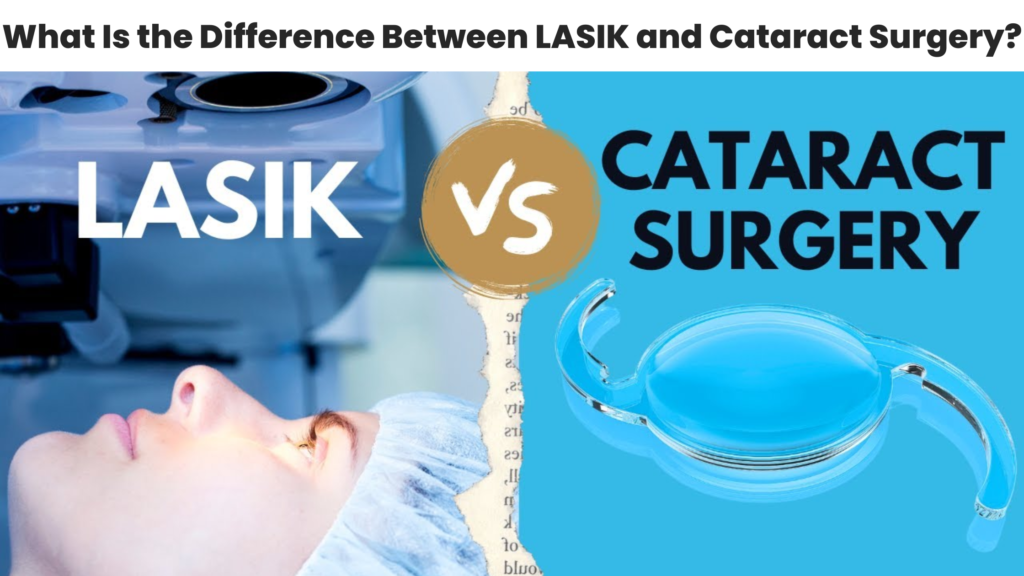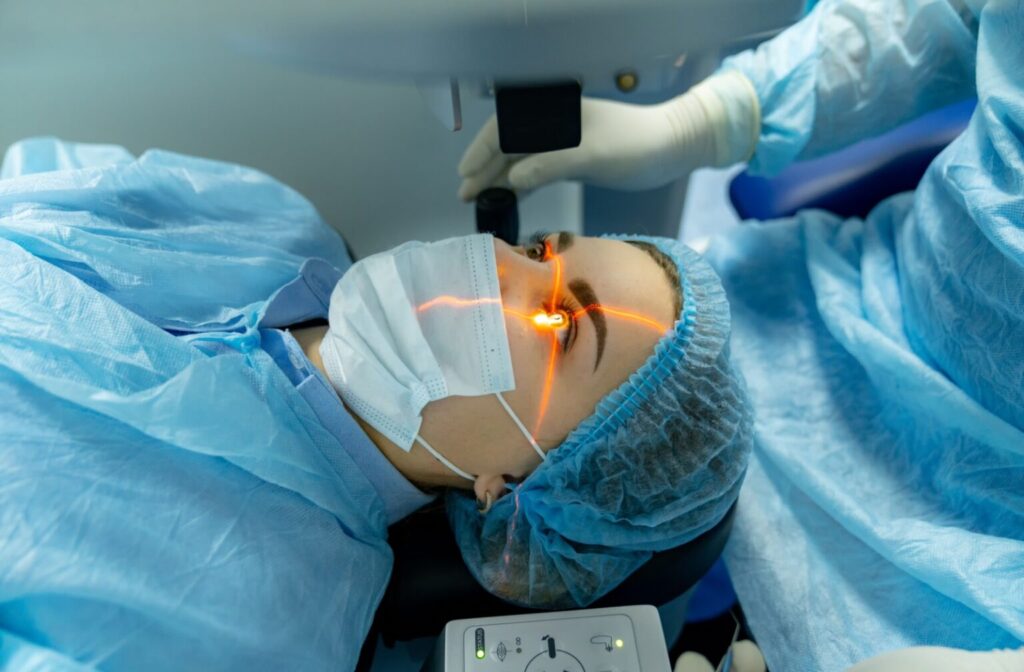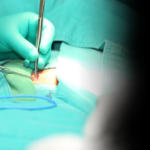
Eye care is a complex field with various procedures designed to correct vision problems. Two common surgeries—LASIK and cataract surgery—are often compared, but they address very different eye conditions. In this blog, we’ll break down what each procedure involves, the conditions they treat, and how they differ, so you can make an informed decision about your eye care.
Understanding Cataract Surgery
Cataract surgery is a widely performed procedure that focuses on restoring vision by addressing the cloudiness in the eye’s natural lens.
What Are Cataracts?
Cataracts are cloudy regions that develop in the crystalline lens of the eye. They are typically associated with aging and can lead to:
- Blurry vision
- Sensitivity to light
- Faded colors
- Double vision
- Difficulty with night vision
These symptoms may start gradually, affecting tasks like reading or driving at night, and, if left untreated, can eventually result in significant vision loss.
When Do I Need Cataract Surgery?
In the early stages, minor vision changes due to cataracts might be manageable with prescription glasses. However, as cataracts progress:
- Surgery becomes necessary once the cloudiness begins to seriously affect your daily activities.
- Timely intervention is important, as waiting too long can complicate the surgery.
Always consult with your eye care professional to discuss the best timing and treatment options for your condition.
What Does Cataract Surgery Involve?
Cataract surgery is known for its safety and effectiveness. The procedure typically includes:
- Anesthetic Drops: To numb your eyes so you feel no pain.
- Lens Removal: Tiny instruments are used to break up and remove the cloudy lens.
- Lens Replacement: A clear, artificial lens is implanted in its place.
- Recovery: Most patients go home the same day, with vision improvements occurring gradually over the next few weeks.
Most individuals experience significantly improved vision post-surgery, although full healing may take up to 8 weeks.
Understanding LASIK Surgery
LASIK (Laser-Assisted In Situ Keratomileusis) is a refractive surgery designed to correct vision issues by reshaping the cornea.
What Is LASIK?

LASIK surgery aims to correct refractive errors—conditions where the shape of the eye prevents light from focusing directly on the retina. Common conditions treated include:
- Myopia (Nearsightedness)
- Hyperopia (Farsightedness)
- Astigmatism
The procedure involves using a pre-programmed laser to reshape the cornea, allowing light to focus correctly on the retina and improving vision clarity.
When Do I Need LASIK Surgery?
LASIK is an excellent alternative for those who:
- Find glasses and contacts inconvenient: Due to lifestyle, work, or sports.
- Have a stable vision prescription: Eye doctors typically recommend LASIK for individuals whose vision has not changed significantly over time.
- Seek long-term vision correction: It offers a lasting solution for refractive errors.
Consult with your eye care professional to determine if LASIK is the best option for your specific vision needs.
What Does LASIK Surgery Involve?
LASIK is a quick procedure that generally includes two main phases:
Preparation Phase
- Contact Lens Discontinuation: You may be asked to stop wearing contacts for a period prior to the surgery.
- Eye Measurements: Detailed assessments of your cornea help customize the treatment plan.
The Procedure
- Numbing Drops or Medicine: To ensure a painless experience.
- Flap Creation: A small flap is created in the cornea using either a microkeratome (a small blade) or a laser.
- Laser Reshaping: A pre-programmed laser precisely reshapes the cornea.
- Flap Repositioning: The flap is carefully placed back, allowing it to adhere naturally.
After the surgery, patients might experience temporary blurred vision or a gritty sensation, with most people noticing significant improvements within a few days, though complete healing can take up to 2-3 months.
Comparing LASIK and Cataract Surgery
While both LASIK and cataract surgery aim to improve vision, they target very different issues within the eye:
- Targeted Area:
- Cataract Surgery: Focuses on removing a cloudy lens caused by cataracts.
- LASIK: Reshapes the cornea to correct refractive errors.
- Purpose:
- Cataract Surgery: Restores vision by replacing the eye’s natural lens.
- LASIK: Reduces or eliminates the need for glasses or contacts by improving the cornea’s focusing ability.
- Recovery Time:
- Cataract Surgery: Recovery can take up to 8 weeks for complete healing.
- LASIK: Most patients see improved vision within a few days, though full recovery may require a few months.
Understanding these key differences can help you determine which procedure may be more appropriate for your specific eye condition.
Which Procedure Is Right for You?
Deciding between LASIK and cataract surgery depends on the underlying condition affecting your vision:
- Cataract Surgery is necessary for those experiencing vision loss due to cataracts.
- LASIK is ideal for individuals with refractive errors looking to reduce dependency on corrective lenses.
If you’re experiencing vision changes or are curious about your options for vision correction, consult with an eye care professional. They can guide you based on your unique situation and medical history.
Conclusion
Both LASIK and cataract surgery are remarkable advancements in eye care, each addressing distinct problems within the eye. Whether you need to restore vision lost to cataracts or desire freedom from glasses and contacts with LASIK, understanding the differences between these procedures is key to making an informed decision.
If you’re concerned about your eye health or think you might need surgery, book an appointment today with one of our experts at Aapka Care Eye Specialists. Our dedicated team is committed to providing you with personalized care and the best possible outcomes for your vision.
By staying informed about the differences between LASIK and cataract surgery, you can take proactive steps towards maintaining your eye health and ensuring a brighter, clearer future.



